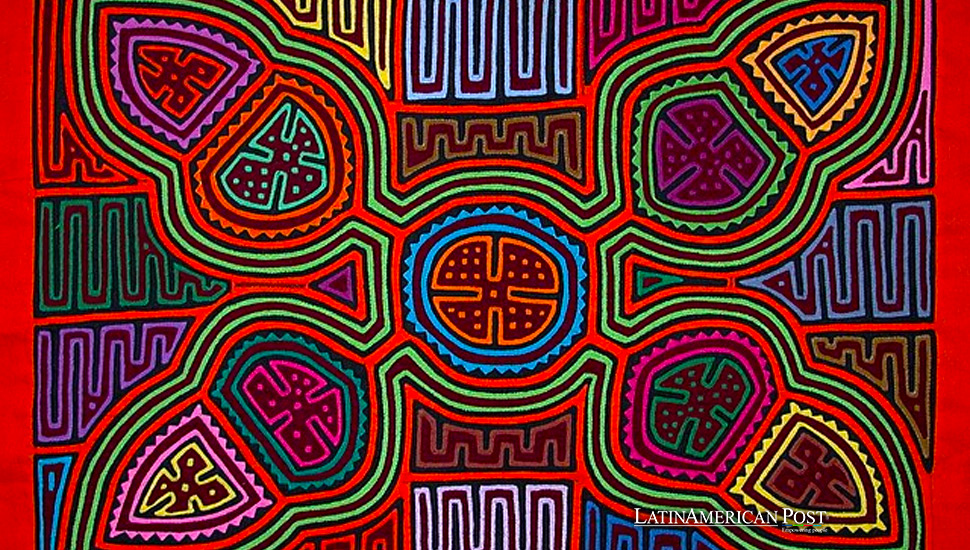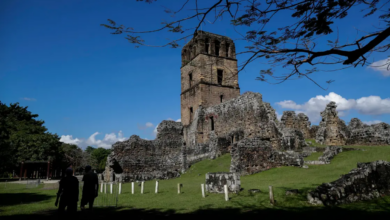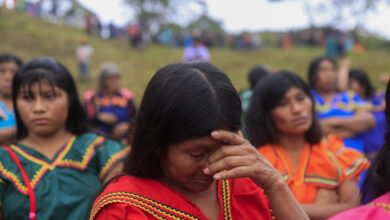Panama’s Indigenous Mola Art Saves Cultural Identity

In the vibrant archipelago of Guna Yala, Panama; the Guna people weave not just fabric but their very identity into the intricate Mola art. This feature explores the deep cultural significance of Mola, highlighting the beauty and challenges of preserving this unique tradition amid modernity.
Beyond captivating textiles, Mola art embodies the cultural essence of the Guna people of Panama. Each stitch narrates its rich history, intricate beliefs, and enduring traditions. Nestled within the Guna Yala archipelago, an emerald necklace of islands off the Panamanian coast, Mola transcends mere artistry, becoming a vibrant tapestry woven into the fabric of Guna life, identity, and heritage.
Historical and Cultural Background
Mola’s origins can be traced back centuries, evolving from the Guna people’s body painting practices. Early iterations utilized natural pigments on bare skin, serving as a form of adornment and cultural expression. As interactions with European settlers increased, the Guna incorporated colorful fabrics into their artistic repertoire. The laborious technique of reverse appliqué, meticulously layering and hand-stitching fabrics to create intricate designs, became the hallmark of Mola art.
Mola designs are not merely decorative; they are windows into the rich tapestry of Guna culture. Geometric patterns, often inspired by nature’s bounty, represent the interconnectedness of all living things. Symbolic animals, like the jaguar and the eagle, embody strength and courage, while vibrant colors hold specific meanings within the Guna worldview. Each Mola narrates a story showcasing the Guna people’s profound connection to their ancestral lands, vibrant mythology, and deeply held values.
The Artistry of Mola
Creating a Mola is a testament to artistic dedication and meticulous attention to detail. Skilled artisans, predominantly women, begin by selecting vibrantly colored fabrics, each layer meticulously chosen to add depth and dimension to the final design. The chosen fabrics are then hand-stitched, layer upon layer, with intricate patterns meticulously cut away using specialized tools. This laborious process, often requiring days or weeks, transforms simple cloth into captivating works of art.
One such masterpiece is the Mola by revered artist Aliena ‘Lela’ Guna. Her vibrant “Jaguar Spirit” piece depicts the powerful animal with intricate geometric patterns and symbolic colors. “Each stitch,” Lela explains, “honors our ancestors and carries the stories of our people.” Her words capture the essence of Mola art – it is not just artistic expression but a bridge connecting generations and preserving a rich cultural heritage.
Mola in Guna Society
Mola panels traditionally formed the central adornment of a woman’s blouse, known as a “dulcimer.” These colorful blouses, adorned with intricate Mola designs, served as vibrant expressions of Guna’s identity and social status. Beyond attire, Mola plays a significant role in Guna ceremonies and rituals. Unique Mola panels are crafted for specific occasions, serving as ritualistic offerings and reflecting the deep spiritual connection embedded within the Guna culture.
Furthermore, Mola is a powerful tool for storytelling and cultural transmission within the Guna community. As mothers pass down the intricate techniques and symbolic language of Mola making to their daughters, they share a valuable skill and transmit generations of cultural knowledge, narratives, and traditions.
Challenges to Preservation
However, the future of Mola art has its challenges. Globalization and the influx of manufactured goods pose a threat to the traditional techniques and economic viability of Mola making. The risk of cultural appropriation, where Mola designs are commercially reproduced without respect for their cultural significance, further complicates the artistic landscape.
Despite these challenges, the Guna people are fiercely committed to preserving their heritage. Educational initiatives within Guna communities aim to ensure the transmission of Mola-making skills to younger generations. Additionally, legal protections have been established to safeguard the cultural integrity of Mola designs and empower Guna artisans.
The Globalization of Mola
While globalization presents challenges, it also offers cultural exchange and appreciation opportunities. Mola art has captivated international audiences, finding its way into museums, art galleries, and global markets. However, navigating this space requires careful consideration to avoid cultural appropriation.
One successful example is the Guna Yala Mola Cooperative. This artist-run organization ensures fair compensation for Guna artisans while promoting their work ethically and respectfully internationally. Such initiatives showcase the potential of globalization to foster cultural appreciation and economic empowerment for indigenous communities.
Voices from the Community
“Mola is more than art; it is our voice,” shares Elisa, a young Guna artist. Her vibrant Mola, depicting a community gathering, reflects her connection to her heritage and her aspirations for the future. “We weave not just patterns, but our stories, dreams, and hopes for future generations.”
Elisa’s words highlight the profound significance of Mola art, particularly for Guna women. It is a source of cultural pride, economic empowerment, and artistic expression. Many women, like Elisa, are actively involved in preserving the tradition while seeking innovative ways to share their art with the world. They participate in workshops and cultural exchange programs, educating international audiences about the cultural significance of Mola and fostering respect for their artistic heritage.
The Future of Mola Art
The future of Mola art hinges on a delicate balance between tradition and innovation. While preserving time-honored techniques and cultural narratives is crucial, embracing sustainable practices and exploring new avenues for artistic expression can ensure Mola’s continued relevance in the modern world.
Efforts are underway to support the future of Mola art. Educational programs aim to teach the technical skills of Mola making and instill in younger generations a deep appreciation for their cultural heritage. Additionally, initiatives focused on sustainable practices, such as utilizing eco-friendly dyes and promoting responsible tourism, are crucial for ensuring the long-term viability of Mola art within the Guna communities.
Also read: Panama Inaugurates Cultural Mega-Complex
Mola art transcends the realm of artistry, pulsating with the lifeblood of the Guna people. It is a testament to their enduring cultural heritage, a vibrant tapestry woven with stories, symbols, and ancestral wisdom. As the world becomes increasingly interconnected, recognizing the significance of Mola art and fostering a respectful appreciation for its cultural context is crucial. By supporting educational initiatives, promoting cultural exchange, and ensuring fair economic opportunities for Guna artisans, we can collectively ensure that Mola art continues to thrive as a captivating art form and a vibrant expression of Guna’s identity for generations to come.




